Excelsior Park

Excelsior Park was a watch movement company active from 1886 through 1983. The name was used again in 1986 and since 2020. It was formed by the sons of Jules-Frédéric Jeanneret, who had been active in watchmaking since the 1860s, and the firms were close enough that Excelsior Park was often said to date "Since 1866" though it was not a separate company until two decades later. The company is closely associated with the Jeanneret family of Saint-Imier and their factory there, called Usine du Parc.
Overview
A watchmaking businesses was set up in the area of Saint-Imier by Jules-Frédéric Jeanneret by 1865, and this was be the predecessor to Excelsior Park. The Jeanneret family was active in many watchmaking enterprises in Saint-Imier around the turn of the century, and these firms shared a great deal around this time, including workers, designs, and factory space. The predecessor firm to Excelsior Park officially dates to April 7, 1886, when Albert Jeanneret and his brothers formed Alb. Jeanneret & Frères, and it was his youngest brother, Henri Jeanneret-Brehm, who adopted the Excelsior Park name, drawing from the family brand Excelsior and the common name for his factory, Usine du Parc. The firm was operated by Henri's son Robert-Henri Jeanneret following his death in 1932 and by his son Robert-Edmond Jeanneret in the 1970s. The Excelsior Park factory was officially closed on March 31, 1983 and liquidated three years later.
Throughout its history, Excelsior Park focused on specialty timing devices, mainly stopwatches and chronograph watches. The company did produce a few simple watches but these are exceedingly rare. Excelsior Park chronograph movements were well-respected and were notably used by Gallet, Girard-Perregaux, and Zénith, among other firms. But the company lacked the resources to develop new movements in the 1960s and suffered as the price for chronographs fell and the value of the Swiss franc rose. Excelsior Park remained independent even as competitors like Valjoux, Venus, Martel, Leonidas, and Lemania were merged into larger groups or watchmaking firms.
Jules-Frédéric Jeanneret
- Seel Also: Jules-Frédéric Jeanneret
The originator of the line is Jules-Frédéric Jeanneret. He is listed as a finisseur in the outskirts of La Chaux-de-Fonds, an area called Reprises, in 1866, and this is the date traced by many of his family firms. He came from Dombresson, though his family was originally from Valangin. In Dombresson, Jeanneret married Cécile Sandoz, and the couple had two daughters and six sons, all of whom became watchmakers. Three of Jules-Frédéric's sons would be especially notable: Henri founded Excelsior Park, Albert founded Moeris with Fritz Moeri, and Constant took over Leonidas.
Jules-Frédéric Jeanneret's home workshop was bankrupt by 1868, but he had already moved to Saint-Imier to establish a new watchmaking partnership with Edouard Fallet in 1866. The firm was known as Jeanneret et Fallet through 1882, and Jeanneret et Fils from 1883 through 1886, as Jules-Frédéric and Edouard go their separate ways. After his death, Cécile would continue the firm before handing it over to his nephew Samuel Jeanneret, but the house at Rue de Tramelan would continue to house the Jeanneret family firm for decades.
By 1890, advertisements list Vve. Jules-Fréd as a specialist watchmaker focused on interchangeable components and chronographs. By this time, Jeanneret had registered the Pigeon brand and had won a silver medal at the Anvers exposition in 1885. It is in this time period that the supplier relationship between the Jeanneret family and Gallet began.
Alb. Jeanneret & Frères and Usine du Parc
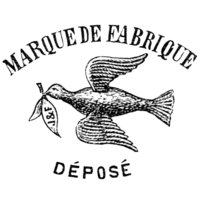
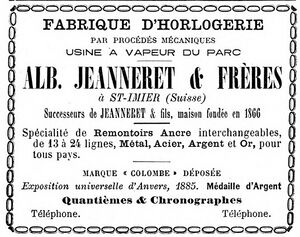
It is said that Jules-Frédéric Jeanneret and his brother in law Fritz Thalmann purchased the steam-powered factory on Rue du Pont known as Usine du Parc in 1885. This was the former home of Rahm et Monnier and existed at least since 1883. On June 14, 1885 the factory was struck by lightning, with the newspaper Le Jura noting that it was run by Mr. Thalmann and Jeanneret.
Soon his oldest son Albert Jules moved his family to the house on the property, leaving Jules-Frédéric at 34a Rue de Tramelan. The Jeanneret brothers also established a second factory known as Usine Centrale just up the hill from the family home at Rue de l'Hôpital 4.
Albert registered his own company with his brothers, Henri and Constant, at Usine du Parc as Alb. Jeanneret & Frères on April 7, 1886. This company operated for a few years before Albert left to start his own firm with Fritz Moeri. The firm then registered a trademark dove holding a leaf marked "J&F" on June 15 of that year, followed by the Diana brand with a wild boar head in 1888. The Colombe and Excelsior brands were registered on September 17, 1891 by the company.
Even though Jules-Frédéric Jeanneret's company continued in operation without his sons, the new Jeanneret & Frères firm was listed as a successor by 1889. This shows the close lineage of the Jeanneret family firm and justifies the later claims by Excelsior Park to date to 1866. After Albert changed his focus to Moeri & Jeanneret in 1892, Henri and Constant's firm was simply called Jeanneret Frères.
The operation at 296 Rue du Pont advertised that it used a steam plant to power its production machines, with the slogan "usine (a vapeur) du parc." This company boasted of winning the 1885 silver medal, advertising its use of the Colombe and Diana brands, the latter registering a wild hog as a logo image.
Both Jeanneret firms of Saint-Imier advertise in Indicateur Davoine from 1890 through 1892, three advertise through the turn of the century, and four are listed after this.
Jeanneret-Brehm and Excelsior Park
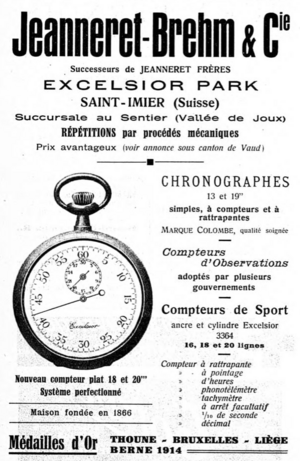
Henri Jeanneret-Brehm renamed the company at Usine du Parc for his own alliance name, Jeanneret-Brehm & Cie, as of July 1, 1901. Jeanneret-Brehm would become the direct predecessor to the well-known company, Excelsior Park. The Jeanneret watchmaking dynasty expanded in 1904 as Constant left to focus on his brand, Junior, which was originally registered by Paul-Louis Droz that same day in 1901.
This complicated history left four different companies operating in Saint-Imier, all claiming to have been "fondée en 1866", as a 1902 advertisement in Indicateur Davoine shows. Given that all were descended from Jules-Frédéric Jeanneret's family, this claim is understandable if somewhat inexact.
By 1902, Jeanneret-Brehm was using the Excelsior name for 18 and 19 ligne chronograph movements, and noted in advertisements that these were intended for "Italie et Portugal" watches. The company also produced "Compteurs de sport" (30-minute stopwatches) and other timing devices. Jeanneret-Brehm purchased the Magnenat-LeCoultre factory in Le Sentier in 1911 to add complicated repeater movements to their repertoire, but that trend quickly passed. It is often claimed that the Gallet company or family provided financial assistance in this purchase but this is not supported in primary or contemporary sources. Gallet had recently merged with Electa and opened its own factory in 1913, so it is not clear why they would support this purchase.
The Excelsior name had been used by the company for two decades, but Jeanneret-Brehm added the English "Park" in 1912. It is often said that this was the suggestion of Gallet to make their products more accessible to English-speaking buyers, and they had a few "Park" brands, but it is likely that the inspiration came from Jeanneret-Brehm's home, which was simply called "Le Parc", and the name of the factory. The first public use of the Excelsior Park name came a few years later, though many watches simply said "Excelsior" on the dial. But the new name rapidly replaced the old in reference to the company, with the Jeanneret name gone entirely from advertisements in the 1920s.
Jeanneret-Brehm & Cie. became Les Fils de Jeanneret-Brehm in 1918 as his sons became more involved. One son, Robert-Henri Jeanneret, took over management that year and would manage the company through the 1960s. In 1925 the company is simply called Excelsior Park, though the people of Saint-Imier continued to refer to the factory as Usine du Parc for decades.
Excelsior Park SA
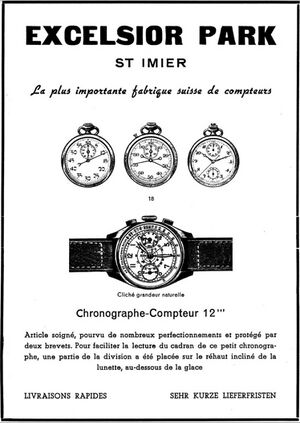
Henri Jeanneret-Brehm died on August 4, 1932 at the age of 76. He had long suffered a painful illness. The firm remained in family hands, however. In their place, Robert-Henri Jeanneret managed the factory before turning it over to his son, Robert-Edmond Jeanneret, grandson of Jules-Frédéric. He oversaw the end of Excelsior Park, which closed shortly before his death in 1985.
From 1918 through 1983, Excelsior Park manufactured a range of stopwatches, branded watches, and watch movements for Gallet, Girard-Perregaux, and Zenith. The company focused on timing movements, including stopwatches and chronographs, and was quite successful in the post-war period. Their chief competitor (especially for business with Zenith) was Martel and their close partner (and owner in the 1940s), Universal Genève.
The rise of wrist chronograph watches in the 1930s and 1940s was a boon for Excelsior Park. Heuer and Breitling helped transform the wrist chronograph from a convenient timer to an indispensable tool for science and sport, and Valjoux, Universal/Martel, and Excelsior Park capitalized on this success. The company offered a compact and inexpensive 12 ligne 2-pusher chronograph movement by 1939 and these soon appeared on the wrists of military officers deployed during World War II. Other innovations from Le Parc include a tachymeter scale and wide diamond-shaped hands, both patented by the firm.
Although Excelsior Park movements were more affordable than those produced by Valjoux, the company resisted mass production and the adoption of cam switching like Vénus and Lemania. All three competitors were absorbed into holding companies Ebauches SA and SSIH, giving them increased market power. After the war, Excelsior Park became a reliable producer of finely-crafted chronograph and stopwatch movements, especially in sport and science. Their "Totalisator" was a symbol of post-war efficiency, adding a function to calculate individual and cumulative production and winning first place at the Swiss National Exhibition in 1964.
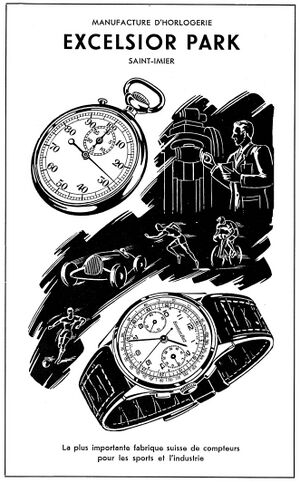
Perhaps the greatest technical accomplishment for Excelsior Park was Cal. JB42, introduced in 1938. An extremely well-designed column wheel chronograph, it incorporated the earlier technical advances from the earlier Cal. JB4 packaged on an unusual oval-shaped main plate. Measuring 12x13 ligne, Cal. JB42 enabled customers like Girard-Perregaux, Gallet, Moeris, and Zénith to produce unusually compact and attractive chronograph watches. Some versions included a 12 hour totalizer while others had the clean two-register "Compax" look popularized by Universal. Cal. JB42 was one of the first chronograph movements with a 45 minute counter rather than 30 minutes, and this was a differentiator for early models like the Gallet Commander and MultiChron.
A few notable innovations appeared in Excelsior Park watches in the 1940s: The orienteering hand, the decimal chronograph, seconds adjuster. Of these, only the orienteering hand is a true complication, adding a central 24 hour hand to the existing movement that can be used as a compass. The decimal chronograph was simply a decimal scale added to show tenths-of-a-minute in industrial timing. The seconds adjuster was a left-side crown that directly acted on the seconds hand, allowing it to be turned to zero. All of these innovations appeared in Excelsior Park and Gallet watches in the 1940s, though many other customers did not implement them.
But the market shifted in the 1950s, with chronographs briefly falling out of favor before cheaper models were embraced by younger buyers in the 1960s. Stubbornly sticking to tried-and-true movements, Excelsior Park was left on the sidelines as cross-town rival (and fellow Jeanneret firm) Leonidas became a maker of cheap stopwatches and was merged into Heuer and Martel was acquired by Zenith. Like Pierce, Excelsior Park lacked the resources to develop an automatic chronograph in the 1960s and was increasingly reliant on expensive and outdated movements like the oval Cal. JB40.
Excelsior Park faced many difficulties and nearly ceased operations in 1975 as the American market, which made up as much as half of sales, switched to cheaper Asian or electronic timers. Still, production in Saint-Imier continued until March 31, 1983, when the company sent all the workers home and stopped production. Although companies like Gallet and Revue Thommen were able to purchase some remaining stock, the brand and factory went unclaimed. The company was finally liquidated on December 12, 1985, shortly after the death of fourth-generation president Robert-Edmond Jeanneret in May. The name went to Flume Company of Germany who were unable to revive it.
Excelsior Park in Modern Times
German toolmaker Fume purchased the respected Excelsior Park brand in 1986 and attempted to revive the company after the quartz crisis. Their offerings relied on leftover Valjoux 7740 and Chronomatic movements rather than classic Saint-Imier products and the firm found little success. The brand was later owned by the American retailer Tourneau.
In 2020, the Korius group purchased the brand and is currently in the process of another revival. The first watches were delivered in 2022 and use Valjoux-derived movements produced by Sellita. They sell in the entry-luxury price band below US$ 4,000. Social media posts by the team suggest that future models will use movements produced by the new Landeron Swiss Movements.
Movements
- Cal. JB1 Family - 18 ligne stopwatch movements, patented in 1891
- Cal. JB1 - 18 ligne stopwatch movement
- Cal. JB11 - 18 ligne rattrapante stopwatch movements
- Cal. B - 18, 20, and 22 ligne high-beat stopwatch movement
- Cal. JB2 - 43 mm "Compteur"
- Cal. JB20 - Compteur avec compteur d'heures
- Cal. JB22 - Distance entre les deux aiguilles compteur-rattrapante
- Cal. JB222 - Distance entre les deux aiguilles compteur-rattrapante
- Cal. JB4 Family - 14 ligne column wheel chronograph movements
- Cal. JB4 - 14 ligne chronograph movement
- Cal. JB4-68 - Movable hairspring stud
- Cal. JB4-24h - 45 minute counter and 24 hour hand
- Cal. JB40 - 45 minute counter
- Cal. JB40-68 - Movable hairspring stud
- Cal. JB42 - 45 minute counter, oval shape (12×13 ligne/27.1x29.4 mm)
- Cal. JB5 - 23.5 or 26 mm
- Cal. JB51
- Cal. JB6 - 40.6 mm "Compteur-football"
- Cal. JB7 - 36 or 42 mm Rèveil
- Cal. JB15 - 42 mm chronograph
- Cal. JB16 - 42 mm, 4.5 mm
- Cal. JB17 - 42 mm, 5 mm
Patents
- CH85, January 10, 1889 - Perfectionnements apportés à la construction des montres de tous calibres.
- CH3364, March 21, 1891 - Compteur-chronographe. - introduced the famous J-shaped bridge, registered by Alb. Jeanneret & Frères, transferred to Jeanneret Frères on October 20, 1894 and to Jeanneret-Brehm on December 4, 1901
- CH24676, October 29, 1901 - Assortiment (pendant ovale et couronne) pour montres. - deleted January 1905
- CH61739, October 14, 1912 - Montre à double tour d'heures. - a watch with two concentric geared dials that can be rotated relative to the primary hands
- CH95253, March 9, 1921 - Montre de contrôle. - deleted June 1924
- CH97461, August 25, 1921 - Chronoscope. - a simple chronograph with a brake lever and reset button - deleted February 1932
- CH97462, August 25, 1921 - Chronographe avec commande électrique. - deleted February 1927
- CH100230, May 24, 1922 - Mouvement d'horlogerie. - the spare parts container - deleted October 1937
- DE388992, January 28, 1924 - Kloben für Taschenuhren.
- CH103018, December 18, 1922 - Verrou pour pièces d'horlogerie, telles que chronographes, compteurs de sports etc. - a braking switch for hacking seconds - deleted June 1930
- CH104372, April 26, 1923 - Coqueret. - a balance cock that allows for easier servicing - deleted October 1927
- CH128782, October 13, 1927 - Pièce d'horlogerie. - deleted April 1934
- CH135792, December 16, 1929 - Support élastique pour ane de mobiles d'horlogerie. - an elastic shock absorber for the balance wheel - deleted May 1932
- CH161893, June 17, 1932 - Compteur de sport.
- CH161894, June 17, 1932 - Pièce d'horlogerie à chronographe.
- CH207380, August 9, 1938 - Chronographe-compteur. - the jumping counter mechanism used in the Cal. JB4 family
- CH207550, August 16, 1938 - Pièce d'horlogerie à lunette fixe. - a sloped inner bezel found on many later watches
- CH235072, February 23, 1943 - Pièce d'horlogerie. - the seconds adjuster found on some 1950s movements - deleted August 1957
- CH239053, July 10, 1943 - Pièce d'horlogerie. - a three-position crown with a "game" mode - deleted January 1953
- CH254008, September 3, 1945 - Doppelzeiger-Stoppuhr. - the rattrapante mechanism used in Cal. JB11
- CH285850, July 31, 1950 - Pièce d'horlogerie. - a double reset hammer - deleted 1959
- US2641899, June 16, 1953 - Chronograph setting hammer system.
- CH286569, October 21, 1950 - Pièce d'horlogerie à chronographe. - oscillating pinion clutch - deleted 1960
- CH287624, January 10, 1951 - Pièce d'horlogerie à chronographe. - a radial elastic brake for the chronograph mechanism - deleted 1960
- US2641900, June 16, 1953 - Timepiece with chronograph.
- CH304090, October 30, 1952 - Compteur de temps à rattrapante.
- DE1003141, February 21, 1957 - Stoppuhr.
- CH313611, October 22, 1953 - Compteur de temps.
- CH351231, December 31, 1960 - Compteur de temps.
- CH388205, February 15, 1965 - Compteur de temps pour cinéaste.
- CH1300/63, February 1, 1963 - Compteur de temps pour cinéaste.